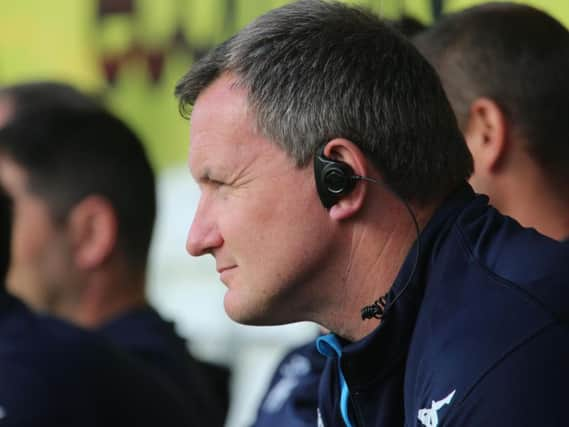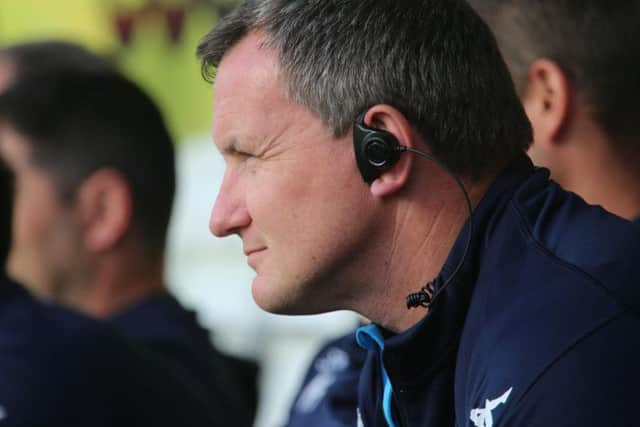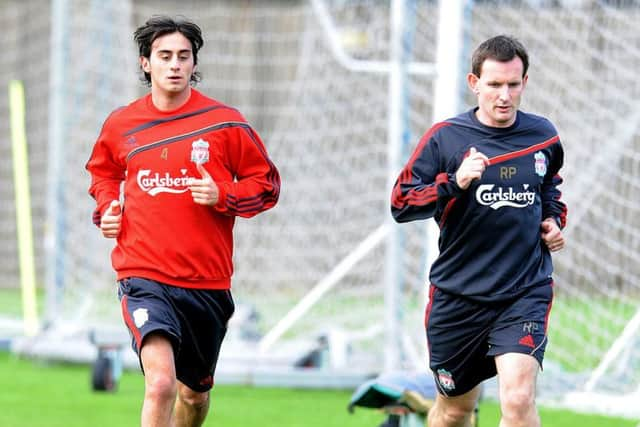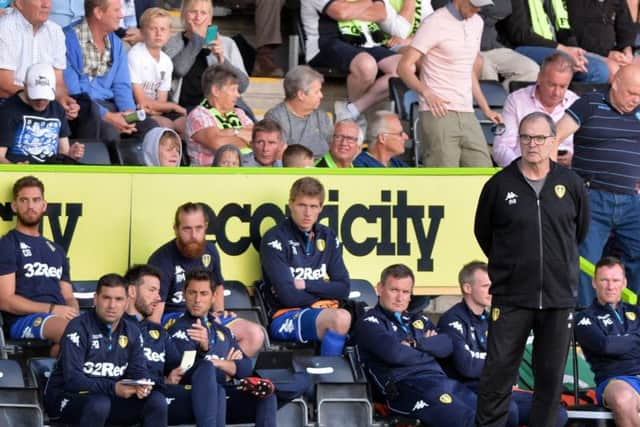Rob Price interview: From Rafa Benitez to Marcelo Bielsa - the man charged with leading Leeds United's battle against injuries


Price served Hull City, the Football Association and Rafael Benitez at Liverpool before becoming Leeds’ head of medicine and performance last summer and the suggestion that Leeds have had more than the average share of injuries on his watch is not in dispute.
“You get good and bad years,” Price says, “and if you look at our numbers then they’re high in comparison to previous years. We’ve had 45 injuries and that’s more than I’ve had in most seasons where I’ve worked in the Championship.”
Advertisement
Hide AdAdvertisement
Hide AdAt no stage has Marcelo Bielsa has a full squad to work with and on the basis that Stuart Dallas could be out for up to six weeks with a fractured ankle, it will be almost April before that happens if it happens at all.


For several months the situation has posed the question of who or what is to blame, or if in fact anything is to blame. Are clubs really this unlucky or is their management of players - on both the football and the medical side - contributing to the casualty list?
The answer, in Price’s view, is nuanced.
Football like Bielsa’s - intense, front-foot, possession-based tactics and a regime in which players have few days off, train like they play and appear for the Under-23s when they are out of the first team - comes at a physical cost and Pontus Jansson was quoted in the Swedish media yesterday as saying Leeds can find themselves feeling “tired before a match”.
But the the makeweight is a Championship table in which Leeds are joint top. There is a view amongst experienced physios that teams with no injuries are not pushing themselves hard enough.


Advertisement
Hide AdAdvertisement
Hide Ad“High performance isn’t healthy,” Price says, and no-one insists on high performance more than Bielsa.
“To get the performances we’re getting and to play a high pressing, intense game, you have to be able to run, you have to be able to sprint and you have to be able to change direction,” Price says. “The more often you do that the more you’re at risk. But if you don’t do it you lose the games. It is a pay-off.
“I wasn’t here last year but if you talk to the players and talk to the staff, a very similar group of players are performing at a much higher level. That’s because of the training we do. If the downside is that you pick up a couple of extra injuries to perform at a higher level, I think it’s a price worth paying.


Advertisement
Hide AdAdvertisement
Hide Ad“You could reduce injuries if you sit back and play a more negative type of football but would you be successful and would you be in the top two? The answer is probably no.”
In any case, Price would not lay the extensive injury list, a list on which only two prominent players, Gjanni Alioski and Mateusz Klich, haven’t featured, at Bielsa’s door. Clubs divide ailments into soft-tissue damage and contact injuries - a fairly clear split between those which are avoidable and those which aren’t - and of the 45 suffered by players at Leeds, more than 70 per cent have been caused by collisions.
Price says re-injury rates, where footballers aggravate an existing problem, are running at only five per cent, well below the average of 12 to 15 per cent.
Some injuries which appeared to be recurrences, like Patrick Bamford’s knee in December, were different issues. Bamford had returned early from PCL damage but was hurt again in training when another player landed on his leg.
Advertisement
Hide AdAdvertisement
Hide Ad“If you watch the video of it, he’d have injured that knee whether he’d had the injury before or not,” Price says. “He injured a different ligament. Someone fell on him, his knee twisted under him. The actual ligament he’d injured before stood up to it and was intact.
“It looks like Bamford’s injured his knee again and everyone thinks it’s the same thing but it’s not. We’re quite open and if it is the same thing then we’ll say so. The disappointing one this season was Pablo (Hernandez) who did his hamstring in September. That’s the one real re-injury we had. He did it crossing a ball in training.”
Price says that in those circumstances, he and his staff go back over the rehabilitation process and look for errors of judgement (in Hernandez’s case, the club still believe that the midfielder had cleared every necessary hurdle before resuming training). He meets up to four times a day with Leeds’ fitness coach Benoit Delaval, rehabilitation coach Ruben Crespo, head physio Henry McStay and two of McStay’s assistants to discuss the progress of injured players and the impact of their schedules.
Advertisement
Hide AdAdvertisement
Hide Ad“We do a retrospective thing where we say (about a player) ‘if you were coming back tomorrow and you were to break down, is there anything we’ve missed?’ We try to do the critical event analysis before it happens and if you tick every box and say ‘there’s nothing we would change’ you’ve reduced the risk as much as you can.
“What you’re trying to achieve is a quick return to play with a low re-injury rate. If a player is about 90 per cent and we’re ready to get them back in, if you keep them an extra three weeks in rehab then the risk of re-injury might only reduce by one per cent. So can you spot that optimum time where risk is low but you don’t prolong them coming back?
“Pat (Bamford) came back and he scored that goal at Bolton which might be enough at the end of the season. Keeping him back two weeks wouldn’t have made any difference when a player fell on him in training.”
Leeds invested in their medical team by recruiting Price from Hull and the club have modernised their equipment since then, including the purchase of a specialist machine for building up muscle strength.
Advertisement
Hide AdAdvertisement
Hide AdBielsa was the big acquisition on the football side, the elite coach with very pronounced plan in his head, and the Argentinian has rolled impressively with the impact of injuries during his tenure. According to Price, the medical team is never under pressure to rush players back, even though he came from Hull with a reputation for cutting down rehabilitation times.
“The best coaches, and you’ve got to put Marcelo in the best-coaches bracket, cope with whatever you give them,” Price says. “If they’re going to panic and fall off because someone breaks down with injury, they’re not going to reach the levels he’s reached.
“What he wants is certainty. If someone’s injured today, how long is he going to be out? That’s all he wants to know. There’s a pride and a drive in what you do to get players back but there’s no pressure put on by Marcelo, or the staff or the players.”
Advertisement
Hide AdAdvertisement
Hide AdEvery injury Leeds suffer is given an initial assessment by Price and another by a second member of staff. Price calls it a “four-eye review”. Scans are analysed by radiologists in Leeds and followed up by analysis by the club doctor and United’s physios.
“Every day there are two or three people asking ‘are they progressing as they should be, are they at the stage where we expect them to be. If they’re not, why not?’ What can we do that’s different?”
Price found when he spoke to Derby’s physio staff last month that injuries at Pride Park had increased from around 20 last season to more than 30 this season, despite no change in the way Derby’s treatment room works.
“You just get seasons like this,” he says. A couple of years ago Benitez made a concerted effort to cut down a problematic injury list at Newcastle United and succeeded in bringing it under control. Might Leeds attempt to do the same?
Advertisement
Hide AdAdvertisement
Hide Ad“When Rafa looked at that, they had a lot of soft tissue injuries,” Price says. “If you’re getting an overload of soft tissue injuries, there are things you can do.
“Our soft tissue injury stats are actually below average this season but you’ve seen how Marcelo prepares for technical and tactical work. He’s exactly the same with physical work and anyone who thinks he wouldn’t look at that with the same degree of introspection and detail would be crazy.”
Bielsa’s training regime will not change, just as his approach to individual games never changes. “He has his philosophy and does not let it go,” Jansson was quoted as saying. Like his tactics themselves, it is risk versus reward: constant high intensity in return for the consistently good results Leeds have been producing until recently.
Advertisement
Hide AdAdvertisement
Hide Ad“The physical stats in games are massively outweighing what we’ve achieved in the time that staff here have been collecting the data,” Price says.
“Marcelo’s a big believer that unless the players train in the week and are able to carry out the play, they’re no good to him on a Saturday anyway. They don’t want players dipping in and just turning up because they’ll be unable to perform.
“There are lots of contact injuries and people always ask ‘why is that?’ A little bit of it is that we’re more on the front foot, we’re inviting more challenges onto us and we’re making more challenges ourselves. We’re outrunning a lot of clubs and when we look at the physical stats from games, quite often - in fact in the majority of games - we’ve had a much higher physical output than the other teams.
“It’s that balance of performance, of being in the top two with the performances we’ve put on this season or having the same players as last year who perhaps weren’t training so hard and weren’t performing.
"If you want to be top of the table, you have to train hard and play hard.”